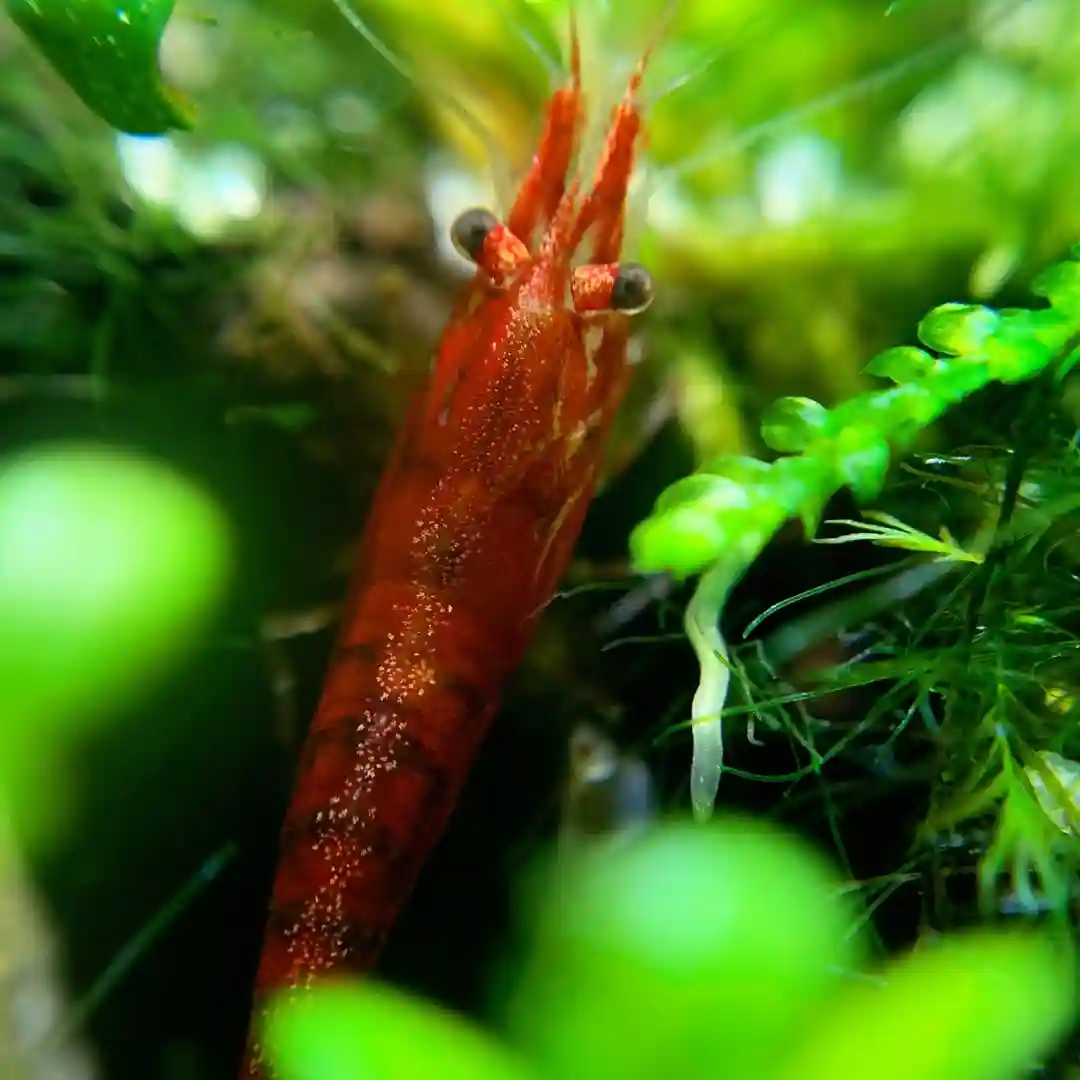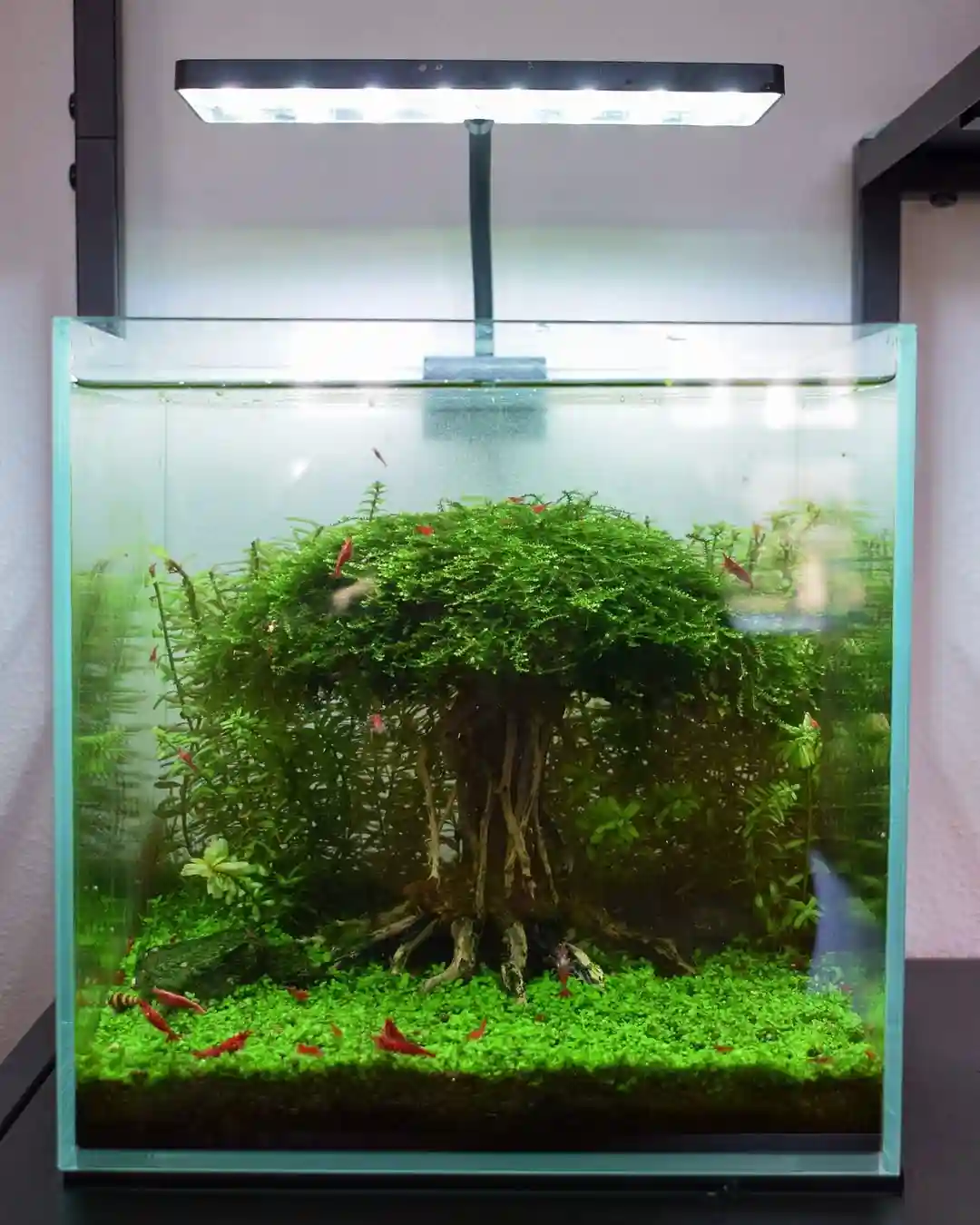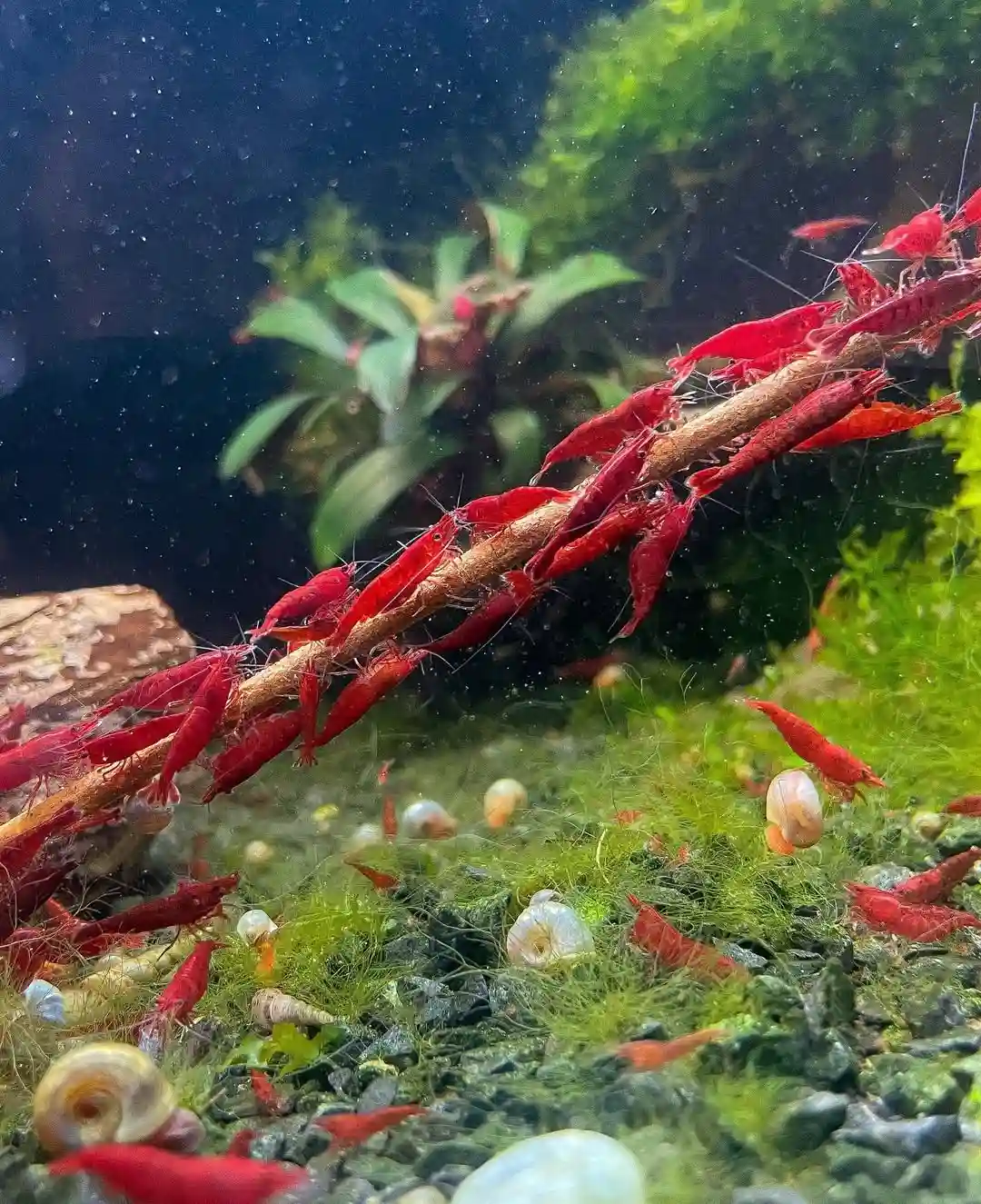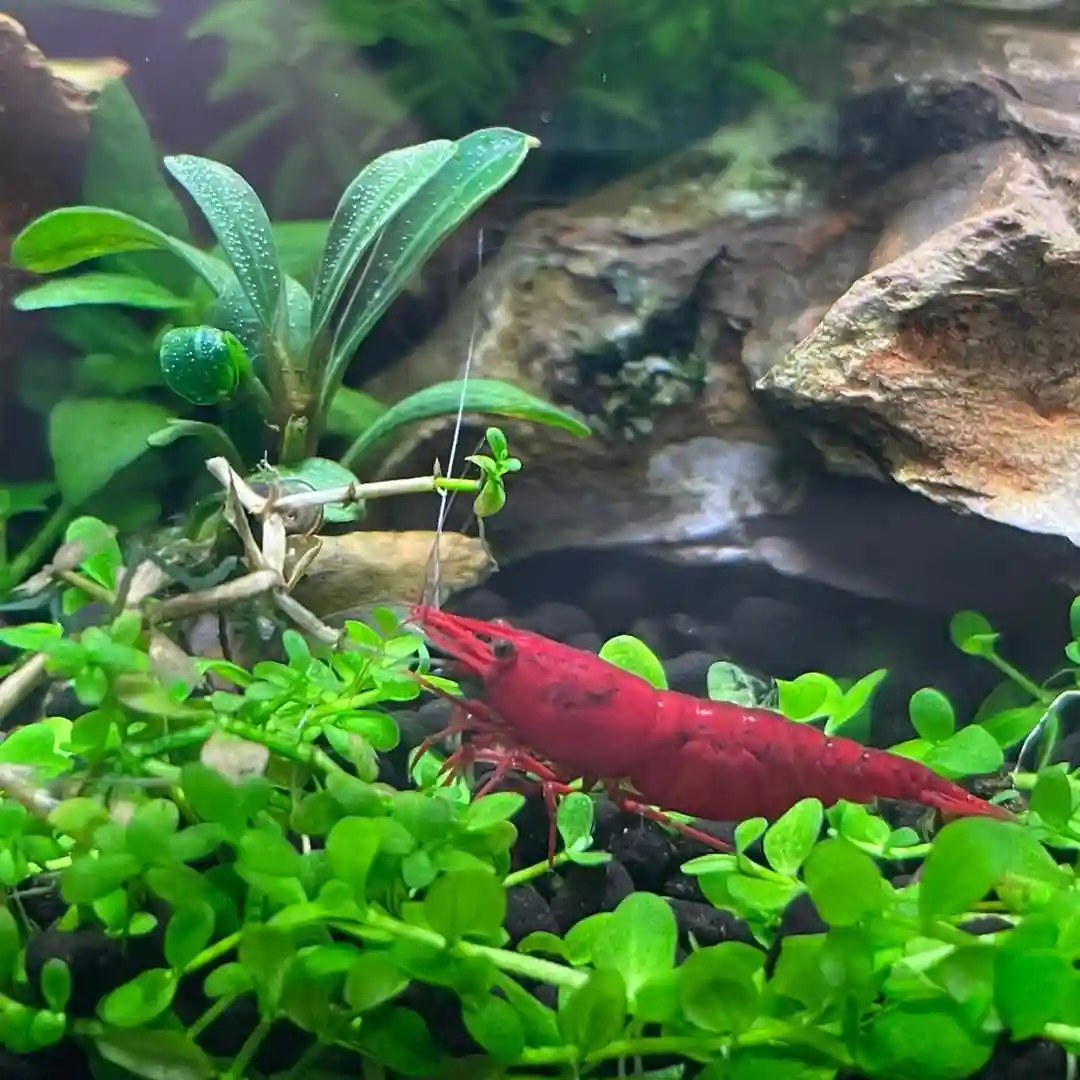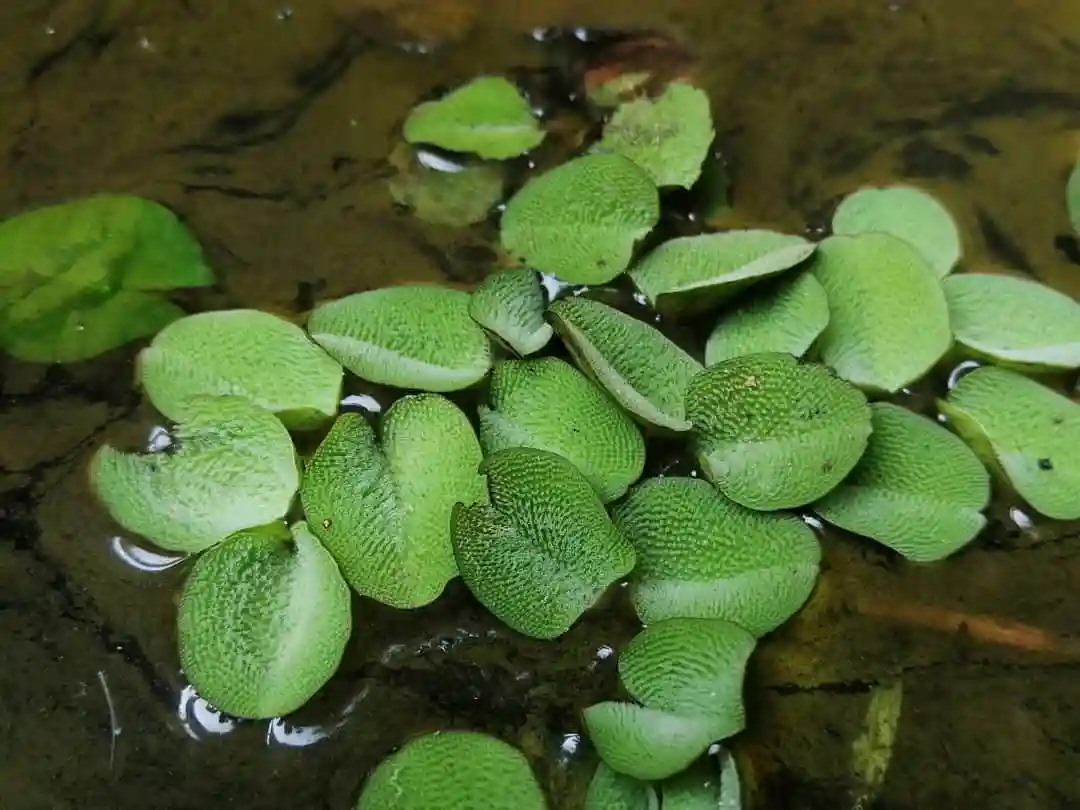Best Shrimp for Nano Tanks (Top 5 Options + Care Tips)
Nano tanks (5-10 gallons) make perfect homes for freshwater shrimp. These small crustaceans add color and movement to your mini aquarium while helping keep it clean. If you’re looking to start a shrimp tank or add some to your existing setup, you’ve come to the right place!
In this guide, we’ll cover:
- The best shrimp species for small aquariums
- How to set up the perfect shrimp habitat
- Simple care tips for healthy, thriving shrimp
- Common problems and how to solve them
- Breeding basics for beginners
The 5 Best Shrimp Species for Nano Tanks

1. Cherry Shrimp (Neocaridina davidi)
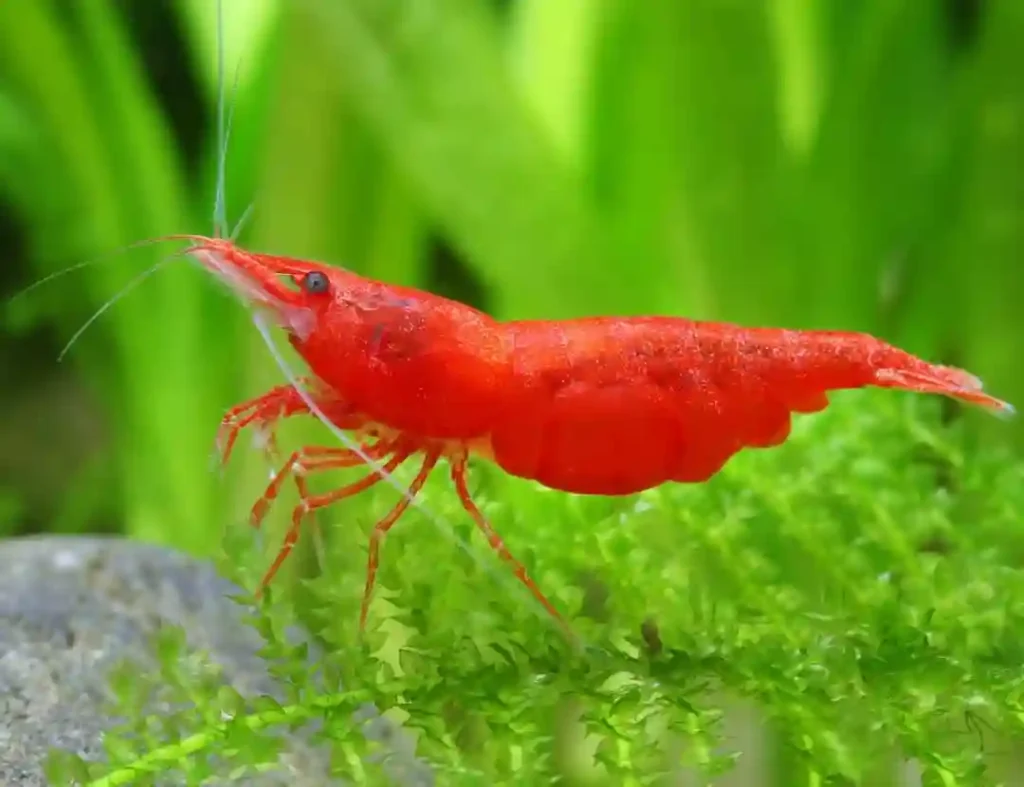
Cherry shrimp are the perfect starter shrimp. Their bright red color makes them easy to spot against green plants, and they’re tough enough to handle beginner mistakes.
Why they’re great for nano tanks:
- Easy to care for – perfect for beginners
- Breed readily in captivity
- Available in many colors beyond just red
- Help clean algae and leftover food
- Small size (1-1.5 inches)
Water parameters:
- Temperature: 65-80°F (18-27°C)
- pH: 6.5-8.0
- GH: 4-8 dGH
- KH: 2-5 dKH
2. Amano Shrimp (Caridina multidentata)
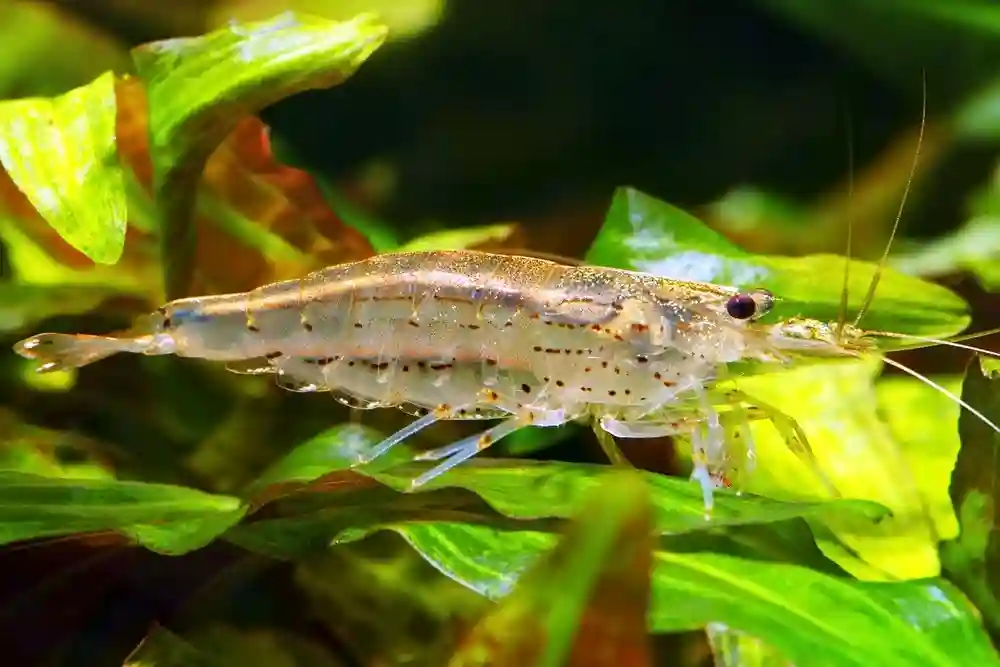
Amano shrimp are the cleanup crew champions of the aquarium world. These larger shrimp (up to 2 inches) are algae-eating machines that help keep your tank clean.
Why they’re great for nano tanks:
- Excellent algae eaters
- Peaceful community members
- Hardy and adaptable
- Less likely to be eaten by small fish
- Live 2-3 years with proper care
Water parameters:
- Temperature: 70-80°F (21-27°C)
- pH: 6.0-7.5
- GH: 4-10 dGH
- KH: 2-6 dKH
3. Crystal Red Shrimp (Caridina cantonensis)
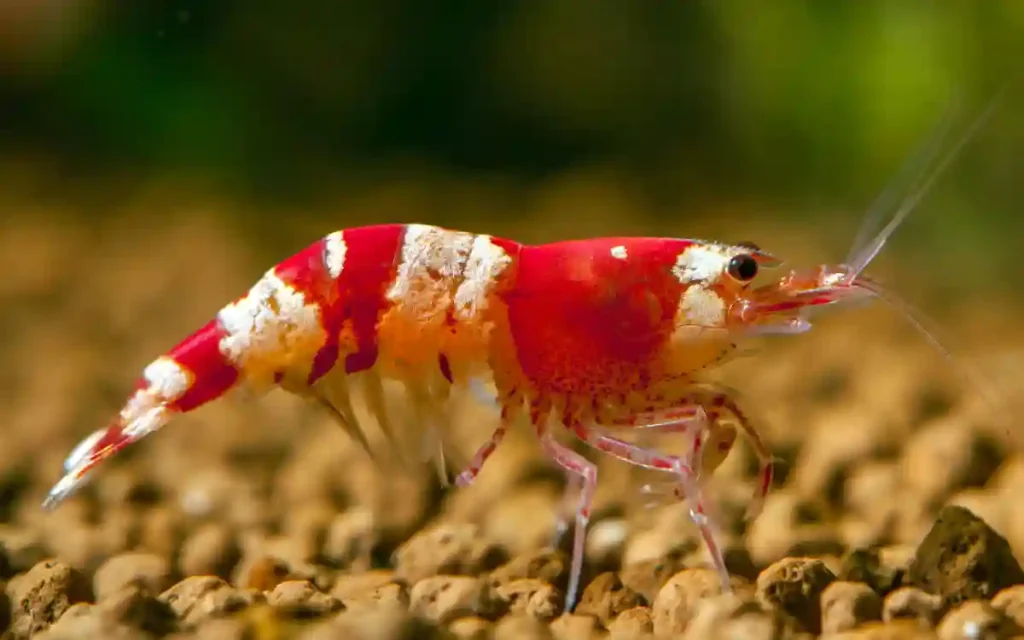
Crystal Red shrimp are the jewels of the shrimp world with their striking red and white patterns. They need more specific care but reward you with their beauty.
Why they’re great for nano tanks:
- Stunning red and white patterns
- Smaller size (1-1.2 inches)
- Available in different grades based on pattern
- Less active, so perfect for smaller spaces
- Become more colorful in proper conditions
Water parameters:
- Temperature: 70-78°F (21-25°C)
- pH: 6.0-6.5
- GH: 4-6 dGH
- KH: 0-1 dKH
- TDS: 100-200 ppm
4. Blue Dream/Blue Velvet Shrimp (Neocaridina davidi)
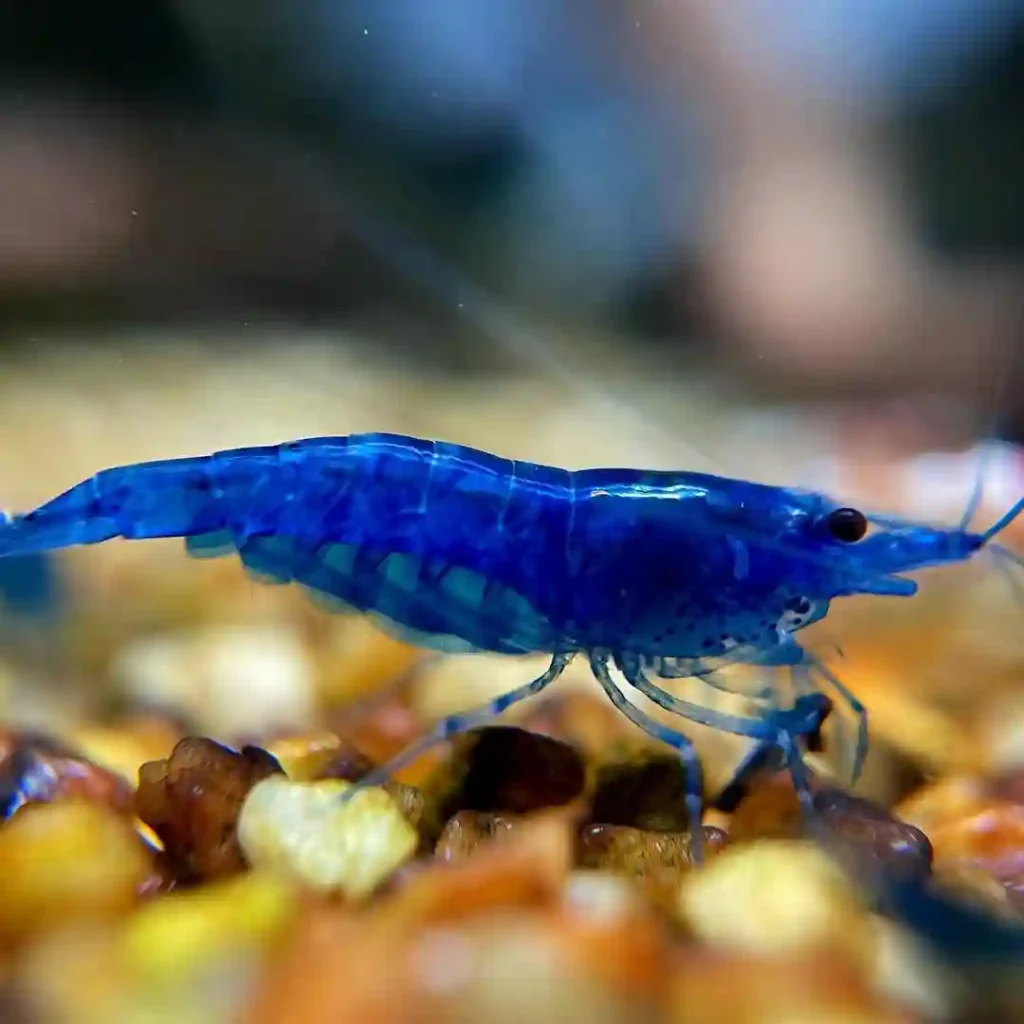
Blue Dream shrimp are a color variant of Cherry shrimp with an eye-catching blue color. They’re just as easy to care for as their red cousins but offer a different look.
Why they’re great for nano tanks:
- Same hardiness as Cherry shrimp
- Striking blue coloration
- Easy to breed
- Active and visible in the tank
- Great algae consumers
Water parameters:
- Temperature: 65-80°F (18-27°C)
- pH: 6.5-8.0
- GH: 4-8 dGH
- KH: 2-5 dKH
5. Ghost Shrimp (Palaemonetes paludosus)
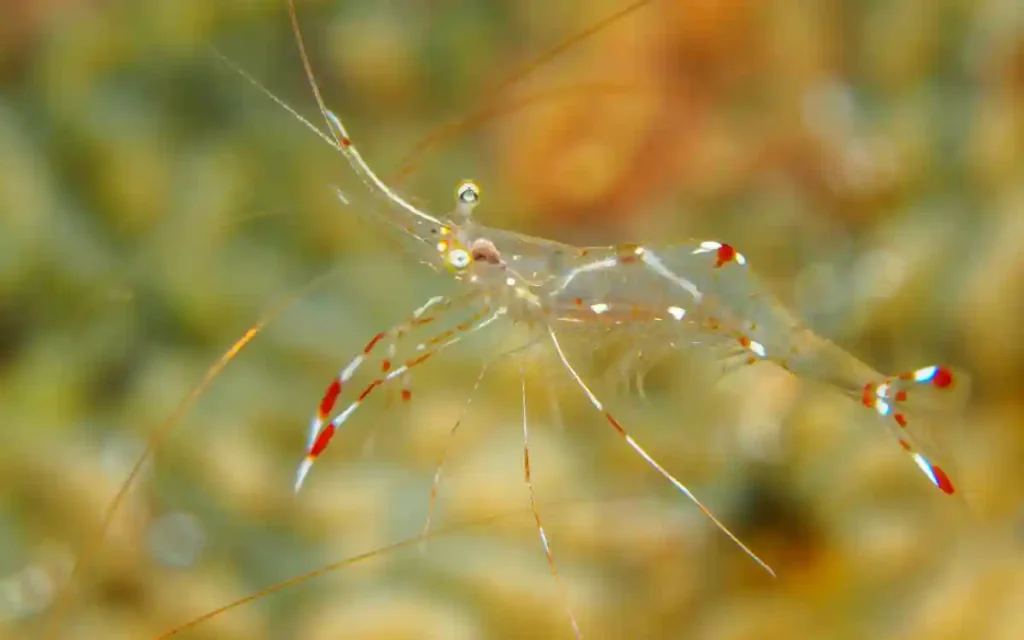
Ghost shrimp are transparent creatures that let you see their inner workings, including what they’ve recently eaten. They’re often sold as feeder shrimp but make interesting pets in their own right.
Why they’re great for nano tanks:
- Very affordable ($0.50-$1 each)
- Interesting transparent appearance
- Excellent scavengers
- Can handle a wide range of conditions
- Entertaining to watch
Water parameters:
- Temperature: 65-80°F (18-27°C)
- pH: 7.0-8.0
- GH: 3-10 dGH
- KH: 3-8 dKH
Comparison: Choosing the Right Shrimp for Your Nano Tank
| Shrimp Type | Difficulty | Size | Lifespan | Special Features | Best For |
| Cherry | Beginner | 1-1.5″ | 1-2 years | Breeds easily | First-time shrimp keepers |
| Amano | Beginner | 1.5-2″ | 2-3 years | Superior algae eater | Algae control |
| Crystal Red | Intermediate | 1-1.2″ | 1.5-2 years | Eye-catching pattern | Experienced keepers |
| Blue Dream | Beginner | 1-1.5″ | 1-2 years | Vibrant blue color | Adding color variety |
| Ghost | Beginner | 1-2″ | 1-1.5 years | Transparency | Budget tanks |
Creating the Perfect Nano Tank for Shrimp
Tank Setup Essentials
Setting up a shrimp-friendly nano tank doesn’t have to be complicated. Here’s what you’ll need:
- Tank size: 5-10 gallons is ideal for starting a shrimp colony
- Substrate: Fine sand or specialized shrimp soil
- Plants: Java moss, Anubias, and Crypts work well
- Hiding places: Small caves, cholla wood, or ceramic tubes
- Filtration: Gentle sponge filter to avoid sucking up baby shrimp
- Lighting: Moderate lighting for 8-10 hours daily
- Heater: May be needed depending on your home temperature
Pro tip: Aged tanks with established biofilm make better homes for shrimp than brand new setups.
Plants That Shrimp Love
Plants aren’t just decoration—they provide food, shelter, and help maintain water quality. The best plants for shrimp tanks are:
- Java Moss: Creates carpet-like growth where baby shrimp can hide
- Marimo Moss Balls: Provide grazing surfaces and look great
- Anubias: Tough leaves that collect biofilm for shrimp to eat
- Water Wisteria: Fast-growing plant that helps remove nitrates
- Amazon Frogbit: Floating plant that provides shade and root structures
Filtration and Water Flow
Shrimp prefer gentle water flow, making sponge filters ideal. Benefits include:
- No risk of sucking up baby shrimp
- Creates gentle water movement
- Provides surfaces for beneficial bacteria
- Becomes a feeding ground as biofilm collects
If using a hang-on-back or canister filter, add a pre-filter sponge to protect your shrimp.
Essential Care Tips for Healthy Shrimp
Water Quality Management
Water quality is the #1 factor in shrimp health and coloration. Follow these guidelines:
- Test water weekly for ammonia, nitrite, nitrate, pH, KH, and GH
- Keep ammonia and nitrite at zero
- Keep nitrates below 20ppm
- Avoid using tap water with copper pipes (copper is toxic to shrimp)
- Use a water conditioner that removes heavy metals
- Perform small water changes (10-15%) weekly
- Match temperature and parameters when adding new water
Feeding Your Shrimp Properly
Shrimp are not picky eaters, but proper nutrition brings out their best colors and promotes breeding:
- Feed small amounts every other day
- Remove uneaten food after 2-3 hours
- Rotate between:
- Commercial shrimp pellets or powder
- Blanched vegetables (zucchini, spinach, carrot)
- Leaf litter (catappa leaves, oak leaves)
- Occasional protein treats (bloodworms, daphnia)
Remember: It’s better to underfeed than overfeed shrimp. They can find food in the biofilm of your tank between feedings.
Compatible Tank Mates
Not all fish work well with shrimp—many will see them as expensive snacks! Good tank mates include:
- Other shrimp: Different species can usually coexist
- Snails: Nerite, Mystery, and Ramshorn snails are peaceful
- Small fish: Otocinclus catfish, small tetras, and chili rasboras can work
- Nano fish: Celestial Pearl Danios and Ember Tetras are generally safe
Warning: Even with “safe” fish species, baby shrimp may still be eaten. For a dedicated breeding tank, consider keeping shrimp only.
Breeding Shrimp in Nano Tanks
One of the joys of keeping shrimp is watching your colony grow naturally. Here’s what you need to know:
The Breeding Process
- Mating: Adult females release pheromones when ready to mate
- Berried females: After mating, females carry eggs under their tails
- Incubation: Eggs hatch after 2-3 weeks depending on species and temperature
- Baby shrimp: Miniature versions of adults that don’t need special care
Supporting a Growing Colony
- Maintain stable water conditions
- Provide plenty of hiding places for babies
- Feed crushed or powdered foods
- Avoid removing too much biofilm during cleaning
- Consider adding mineral supplements if breeding Caridina species
Troubleshooting Common Shrimp Problems
Why Are My Shrimp Dying?
Sudden shrimp deaths typically stem from these causes:
- Water quality issues: Test for ammonia spikes or parameter shifts
- Copper exposure: Check if you’ve added medications or used untreated tap water
- Failed molting: Often due to improper GH/KH balance
- Bacterial infection: Can happen in tanks with poor maintenance
- Predation: Fish may be picking them off one by one
White Ring of Death
This white band around a shrimp’s body often indicates a molting problem:
- Cause: Usually from incorrect GH (mineral content)
- Prevention: Maintain proper GH levels (4-8 for most species)
- Solution: Add mineral supplements designed for shrimp
Color Loss
If your colorful shrimp are turning pale or transparent:
- Potential causes: Poor diet, stress, improper breeding, or water quality
- Solutions: Improve diet with color-enhancing foods, check water parameters, and provide hiding places
Conclusion:
A well-maintained nano shrimp tank offers endless enjoyment. These tiny creatures provide constant activity, help keep your tank clean, and can breed to create a self-sustaining colony. With the right setup and care, your shrimp will thrive and bring life to your small aquatic world.
Whether you choose the beginner-friendly Cherry shrimp or the more demanding Crystal Red variety, the principles remain the same: stable water conditions, appropriate food, and plenty of hiding places. Follow the guidelines in this article, and you’ll be well on your way to shrimp-keeping success.
Ready to start your shrimp journey? Begin with a small group of hardy Cherry shrimp, perfect your tank conditions, and watch your colony grow!
FAQ’s
How many shrimp can I keep in a 5-gallon tank?
Start with 10 shrimp. A healthy colony can eventually grow to 50+ in a well-maintained 5-gallon tank.
Do I need a heater for my shrimp tank?
It depends on your home temperature. Most Neocaridina shrimp do well at 65-80°F. If your room drops below 65°F, use a small heater.
How often should I clean my shrimp tank?
Perform small water changes (10-15%) weekly. Clean the filter sponge in old tank water monthly. Avoid disturbing the substrate too much.
Can different shrimp species live together?
Yes, but be aware that different Neocaridina colors may interbreed, resulting in wild-type offspring. Keep Caridina species with similar water requirements.
Why are my shrimp constantly swimming around the tank?
This “racing” behavior often indicates a water quality problem. Test your water immediately and perform a water change if needed.

